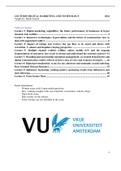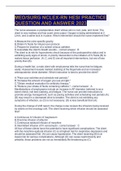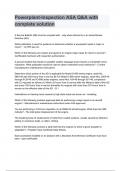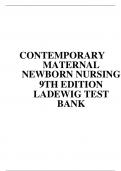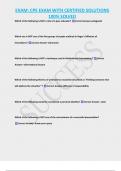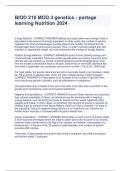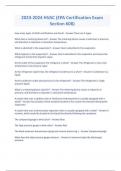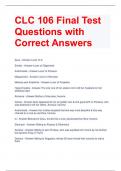Taught by: Emile Lancée
Table of Contents
Lecture 2: Digital marketing capabilities: the future performance of businesses in hyper
dynamic tech realities ................................................................................................................... 2
Lecture 3: Immersive technologies, hyperrealities and the future of consumerism: how to
deal with augmented reality? ....................................................................................................... 6
Lecture 4: Impact of ratings and reviews: the ego likes to be social and shares with
conviction. A valance and impulsive buying perspective. ....................................................... 13
Lecture 5: Multiple channel realities (offline, online, mobile IoT) and the ongoing
fragmentation of customers: how to get in charge and understand the customer journey? 21
Lecture 7: Branding and social media reputation management: co-created brand stories and
digital communication realties. Effects of firm’s tone of voice and response strategies. ..... 26
Lecture 8: Digital personalization: to me, for me, about me and automatic (social) tailoring.
Does it impact firm performance............................................................................................... 35
Lecture 9: Influencer marketing: yielding positive marketing results from influencers and
their following.............................................................................................................................. 40
Lecture 6: Guest lecture Disxt ................................................................................................... 45
Exam information:
- Written exam with 5 open-ended questions.
- Key = linking insights with case materials: screenshots, articles, blogs.
- Open book exam.
- Rely mostly on the articles.
- Guest lectures are not included in the exam
1
,Lecture 2: Digital marketing capabilities: the future performance of
businesses in hyper dynamic tech realities
Articles: Strategic renewal in the digital age: The digital marketing core as a starting point. &
Integrating information technology and marketing: An examination of the drivers and outcomes
of e-Marketing capability
Distinctive capabilities: the unique bundling of skills and resources (technology) that facilitate
the execution of business processes, that ultimately contribute to a sustainable competitive
advantage and superior performance.
Strategic renewal in the digital age: The digital marketing core as a starting point.
To create these distinctive capabilities and become successful, you need four
dimensions; big data, technology, channels, partners.
→ the more these dimensions are integrated, the better.
There are a lot of channels (ways of communication). Because of the
channels, you get data. Being innovative means, you need partners; you
cannot do everything alone (for example for technology).
Resources = things that you own (knowledge, materials, etc.), also known as ‘assets’.
Capabilities = how to use the resources.
Sephora augmented reality app
Which dimensions are used?
The app is a lot of technology.
Use of a channel.
Big data is being used.
→ the service process becomes better
because of technology → data.
The app could be outsourced → partnering.
Netflix
Use of technology, channels, data, and
partners to be successful to change from
physical company to a streaming platform.
They used data to make the company a
streaming platform.
It is a channel and they gather data.
They needed to partner up to make their
service available (e.g., film industry).
2
,What are the reasons for investing in technology?
→ customer oriented
→ to make things more efficient (e.g.,
business process)
→ innovation
Organizational adaptability: a firm’s ability to identify and capitalize both emerging markets
and technological opportunities. They enter into a ’state of adaptation’ when they achieve fit with
their environment, to remain adaptable, technological/digital focus is needed.
This is a graph for technology that can be interesting for companies now or in the future.
See what technology
become important over
time and what can be
useful for companies.
If you use a new
technology, there can be
competitive advantage,
but there is also a risk. It
may not become
mainstream.
3
, Some graphs from other researches → newer technology is not always better.
The higher the level of technology capabilities, the better you are
at using technology
The more technological capabilities you have, the more you
explore technology. However, there is an optimal point. After that,
it decreases. If you’re at the optimal point, you’re “set”.
→ There is also a downside, business wise.
A moderator is included; strategic flexibility.
When businesses are flexible, you can postpone the effect of an
optimal point.
Integrating information technology and marketing: An examination of the drivers and outcomes
of e-Marketing capability
e-Marketing capability: a firm’s competence in using the internet/digital technologies to facilitate
rich interactions with customers (nowadays it is digital capabilities).
→ Linking marketing to technology.
Competitive advantage: not just a function of how one plays the game; it is also a function of the
‘assets’ one has to play with, and how these assets can be deployed and redeployed in a changing
market (adaptability).
Part 1: drivers of e-marketing
capability
Part 2: outcomes
* Interfunctional = information is
spread out through the
organization.
* Market turbulence = when the
market is not stable and changing
needs or demands of the customers.
4


